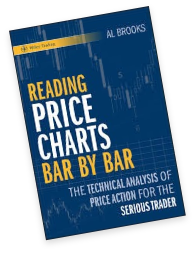21st Jan. 2021
Al Brooks Beginner Course
Module 1 – Introduction
Module 1 is an introduction to the beginner’s course by Al Brooks. It consists of the following units.
Unit 1: Welcome and Course Overview 3min 47sec
A warm welcome to the course and an overview of the four Best Trade setups you will be encouraged to focus on to simplify your trading and achieve successful, consistent trading results.
Unit 2: What Is Price Action? (Q1-Q3) 11min 21sec
The first of 4 units mining Al Brooks’ invaluable knowledge on a range of important questions.
Unit 3: What is Price Action (Q4-Q6) 13min 46sec
The second of 4 units on What is price action. Here you will hear another three important questions answered.
Unit 4: What Is Price Action? (Q7-Q9) 9min 29sec
The third of 4 units on What is price action. Three more important questions answered.
Unit 5: What Is Price Action? (Q10-Q13) 8min 26sec
The last of 4 units on What is price action. A final 4 important questions answered for your serious review.
Module 2 – Major Trend Reversals
Module 2 will teach you about “Major Trend Reversals”. This is the first setup you should learn to master. A Major Trend Reversal is a reversal from a bull to a bear trend, or from a bear trend to a bull trend.
Unit 6: Look for Swing Trades 1min 24sec
Learn why swing trades should be the foundation of your trading business, whether a beginner or experienced trader.
Unit 7: Major Trend Reversals (MTR) 14min 03sec
Learn what to look for when trading the Major Trend Reversal (MTR). Learn to be patient and allow the setup to evolve.
Unit 8: Why Is an MTR the Best Setup? 7min 06sec
Learn why the MTR is the best setup, not only for beginners but for experts too! The prime reason is time.
Unit 9: Minor Trend Reversals 3min 49sec
Here you will learn how to differentiate between a valid Major Trend Reversal, where a trend reversal results, and what may be a Minor Trend Reversal.
Unit 10: Major Trend Reversal Examples 17min
Several Major Trend Reversal (MTR) examples for you to learn how to recognize them in real time.
Module 3 – Pullbacks
For profitable trend trading, you will learn how to trade pullbacks. A pullback is a temporary pause or countertrend move that is part of a trend, swing, or leg.
Unit 11: Pullbacks 9min 37sec
Learn how to differentiate between pullbacks in a trend and a trading range.
Unit 12: Bar Counting 16min 04sec
Bar counting is an effective way of finding pullback entries. Learn how to make good use of this technique to improve your trading.
Unit 13: Bull Channel Pullbacks 22min 37sec
Some bar counting examples in both Tight and Broad Bull Channels to help you learn how to recognize pullbacks in real time.
Unit 14: Bear Channel Pullbacks 12min 39sec
Some bar counting examples in both Tight and Broad Bear Channels to help you learn how to recognize pullbacks in real time.
Module 4 – Trading Range Reversals
The market is forever going through a cycle of trend, Trading Range, trend, Trading Range… forever and ever!
Unit 15: Trading Ranges 13min 43sec
Markets go up, markets go down. Markets also spend a lot of time going sideways in a two sided pattern we call a Trading Range.
Unit 16: Trading Range Reversals 12min 40sec
Learn the basic skills to Buy Low, Sell High, and Scalp when confronted with a Trading Range, especially when a Tight Trading Range.
Unit 17: Trading Range Price Action 9min 33sec
Here you will learn more on validating whether you are in a Trading Range or not. Examples of Trading Range price action to watch for will give you the knowledge, skills, and confidence to trade.
Unit 18: Wedge and Final Flag Reversals 6min 15sec
Wedges are common in Trading Ranges. This unit will help you to see these patterns and take appropriate trades.
Unit 19: Beginners Trapped, Experts Fade 21min 14sec
Second leg traps are common in Trading Ranges. Learn how to recognize potential traps to trade like an expert.
Module 5 – Breakouts
Learn how to identify a breakout, which can deliver higher probability trades.
Unit 20: What Is a Breakout? 10min
You start with leaning the important definition of a breakout.
Unit 21: If Strong Breakout, Must Enter 9min 52sec
When a breakout is strong, you must train yourself to enter! This unit deals with the implications of taking the trade.
Unit 22: Weak Setup and Failed Breakout 12min 15sec
Most breakouts fail! So here you learn more about failed breakouts to improve your performance.
Unit 23: Every Breakout Is a Climax 14min 28sec
A detailed discussion on climatic reversals (failed breakouts) and Exhaustion and Measurement Gaps.
Unit 24: 2nd Legs and 2nd Leg Traps 12min 58sec
More detailed discussion on the importance of 2nd Legs and 2nd Leg Traps.
Unit 25: Strong Bulls and Bears 12min 30sec
Learn about the importance of identifying strong bulls and bears in the market.
Module 6 – Course Conclusion
Wrapping up the course with some help on trading psychology, and some resources to follow up.
Unit 26: Concluding Comments 4min 21sec
Wrapping up the course encouraging you to study all 4 Best Trades setups well, putting in the study time if not done already.
Unit 27: Best Trades Resources 10min 11sec
An introduction to Best Trades resources to help you further in your trading.
Module 7 – Bonus Videos
A presentation on order flow support for price action trading, followed by live trading demonstrations.
Unit 28: Order Flow Support for Price Action Trading 63min 20sec
How the market operates. And how order flow can support price action trading.
Unit 29: Best Trades Live Trading Introduction 19min 51sec
Introductory live trading video with one Buy the Close breakout trade is taken, plus a few missed setup examples.



